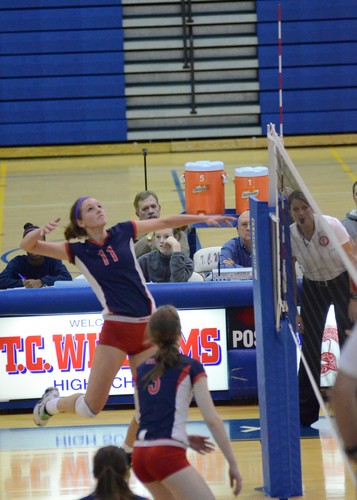Vertical Jump Initial Testing. Is it Really the Bees Knees?
Given that we train a lot of high school volleyball players at SAPT, I'm inevitably faced - on a weekly basis - with two questions that continually pop up from the players, or, more commonly, the parents of the girls: 1) Why aren't you testing my/my daughter's vertical jump on Day 1 as a baseline measurement?
2) Why aren't you doing a lot of plyometric drills with me/my daughter?
 (Note: Although all this is being discussed with regards to volleyball, many of the same principles can be applied to other sports when it comes to verticals and improving change of direction speed)
(Note: Although all this is being discussed with regards to volleyball, many of the same principles can be applied to other sports when it comes to verticals and improving change of direction speed)
While the answers to these questions could easily be an entire article series on their own, I'll do my best to summarize my points here.
1) The vertical jump simply isn't an appropriate test for most (but not all) high school athletes. Not only are there other methods of assessing one's athletic potential, but continually making an athlete jump up and down with maximal effort can be dangerous. Let me briefly explain.
To put it simply: Many high school athletes lack the strength and neural control to execute a solid vertical jump. Just watch nearly any volleyball player do a standing vertical jump attempt on the vertec. However, instead of focusing on their torso, arms, and where their hand smacks the vanes, watch their knees during the countermovement phase of the jump (as they transition from moving down to moving up). What you'll see often resembles my replication in the video below:
May not have noticed that the first time you watched your kid jump, huh? Essentially the athlete is limiting how high they can jump by allowing "force leaks," to take place, in which they end up in sub-par biomechanical position for force production. Not only that, but it is dangerous for their knee health (along with other passive restraints in the lower extremity) to continue practicing like this.
While there are multiple root causes for this phenomenon, a good strength coach can often add a few inches to the athlete's vertical jump by merely teaching the athlete to keep themselves in powerful alignment during the countermovement phase. This involves much more than simply shouting at them to keep their knees out, BTW!
2. Plyometric drills are not a "one size fits all" approach. When you're administering individualized program design for each and every person in the room, as we do at SAPT for all our athletes, it's not a matter of just throwing a bunch of adolescent girls into the same cattle call drills.
Very precise decision making must be made in order to administer and match the exercise to the individual. In fact, any perceptive strength coach who's been in the industry has recognized by now that the more "advanced" and technical exercises (be it jump training, sprint training, medicine ball drills, olympic lifts etc.) will do NOTHING for the athlete unless he/she already possesses the necessary physical and technical preconditions for performing these drills!
As a quick example, we run the strength and conditioning for the majority of the Woodson high school volleyball team (shown in the picture below), who recently won the the district title - and continued to the regional finals and state tournament - for the first time in school history. However, we still give each and every girl on that team an individualized training plan, and this includes their jumping and plyo drills (not the same thing, by the way).
Although all of them together make up a great team, some possess a greater degree of spatial awareness, neural coordination, and strength than others. It would do every individual a disservice to throw them all in the same drills together rather than match the appropriate drill to the person.
Bottom line: Some athletes will be ready for true plyo drills, others will be not-so-ready. A good coach will be able to evaluate the individual and determine where they need to begin along the plyo continuum (if at all).
So, What To Do?
While it is beyond the scope of this post to delve head-first into the myriad progressions/drills that are ideal and appropriate to use, I can at least say that 90% of the athletes I've worked with need to begin by with some variation of drill force reduction. Developing eccentric force absorption and muscle contraction will lay the framework for enhanced concentric strength potential.
What do I mean by this? You can't optimally PRODUCE force until you can adequately ABSORB force. In a vertical jump, the first move that takes place is the force reduction component (lowering yourself to jump) before the actual force production phase (extending body to accelerate upward) during which you leave the ground. The athlete will only be able to accelerate quickly if they are able to efficiently decelerate FIRST.
An example of a Level 1 force absorption drill would be an altitude drop with a stick landing, as shown in the video below. These will drill landing mechanics, develop yielding strength, and create a strong excitation of the CNS.
It looks simple and easy, yes, but you'd actually be surprised at how many top-notch athletes cannot land properly upon initial testing! It is not uncommon to see athletes having difficulty landing properly from a mere 5" box height.
From there, you'll want to progress to elasticity jumps with variable landings in order to the teach the athlete to use his/her active support structures (muscles and tendons) to minimize stress on the passive support structures (bones, ligaments, labrums, etc.).
This will help prepare them the more "real life " scenario come game day.






